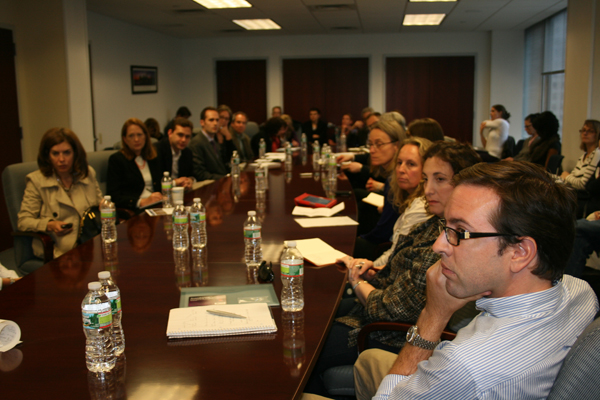
BY ALINE REYNOLDS | The city Department of Education’s proposed solutions to this year’s Downtown kindergarten wait lists were shot down by local parents and education activists at Assembly Speaker Sheldon Silver’s Overcrowding Task Force on Monday.
The number of students wait-listed at the Downtown elementary schools has only dwindled from 85 students to 81 students in recent weeks, and the overall application count for seats in the schools declined by a mere 13 since last year, according to Drew Patterson, director of the Manhattan South planning board for the D.O.E. The D.O.E. expects to see further attrition once the families begin accepting offers to private schools and gifted-and-talented programs.
“We anticipate 40-to-45 of the students currently on the wait lists at the Downtown schools will receive a seat through these mechanisms, which still leaves around 40 students on these wait lists,” said Patterson. “We’re thinking through several different strategies for accommodating these wait-listed students [by June].”
One option is to add an additional kindergarten section at P.S. 276, Patterson said, which could accommodate all of the waitlisted students at the school, but that might require slashing at least one section in future years. Another choice is to open a third kindergarten section at the Tweed Courthouse, which, once the new Peck Slip school incubates there in the fall, is currently slated to house two classes per grade.
But even the latter proposal has its complications. “If we were to add an additional section [at Tweed], it would require split siting that school in year three and looking for an additional location for those sections,” said Patterson.
Task force members had qualms with these proposals. While some parents expressed concern about the Department’s proposal to expand kindergarten at P.S. 276 and elsewhere, others railed against cutting class sections down the road.
“I cannot reiterate enough the need to cap these schools,” said P.S. 234 parent Tricia Joyce, a member of the overcrowding task force. “Clearly, [P.S. 276] cannot sustain one more class — it needs to shrink in size.”
P.S. 276 principal Terri Ruyter cautioned adding kindergarten students this year will cause a shortage of classrooms the following year.
“It’s a short-term solution to a long-term problem,” said Ruyter.
Tammy Meltzer, whose daughter attends P.S. 276, said the only solution is to find new space for the students.
“Reducing the number of kindergarten sections [in future years] is a completely untenable position to take in Lower Manhattan,” she said.
Meltzer said it’s entirely possible to divvy up the space’s four large classrooms — a proposal recently put forth by members of Community Board 1. The classrooms were partitioned while her child attended kindergarten in the basement of Tweed Courthouse, the former incubation site for P.S. 276.
“The sound level was fine… and I think kids were better behaved because they knew there were people on the other side [of the partition],” said Meltzer.
Eric Greenleaf, a business professor at NYU who has extensively studied overcrowding in the Downtown schools, says that two new elementary schools are needed to accommodate the surge of Downtown students.
“Talking about a little bit of space here and a little bit of space there isn’t going to do it,” said Greenleaf. “If P.S. 276 takes even just four kindergarten classes next fall and Spruce takes in just three, [one less section in each school, respectively], that means those two schools will have no room left for 2013 kindergarteners, under very reasonable assumptions.”
No matter what the circumstances are, all Downtown parents should be able to send their children to the neighborhood’s zoned schools, according to Silver, who demanded a more lasting solution to the wait-lists.
“Short-term solutions we’re discussing shouldn’t cover up long-term, continuing overcrowding problems,” said Silver. “That effort must be joined by siting of lower elementary schools as soon as possible.”


































